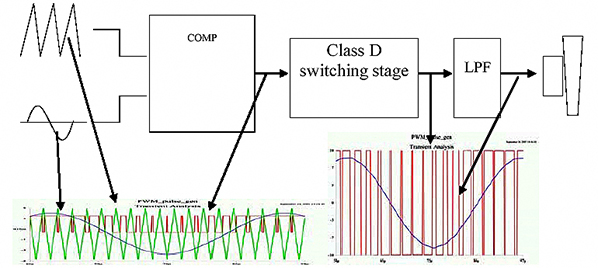
The block diagram would show the power unit further to the left. Its heart is a huge 800VA R-core transformer followed by ultrafast soft-recovery rectifier diodes. The AC is now DC and travels via the two umbilical cords to the amplifier unit. Here the source enters at full tilt without attenuation yet. However, the outboard volume controller sends a control signal to the power amplifier which triggers an analog electronic attenuator right in front of the power stages – and yes, stages as each monoblock is itself dual mono. Whilst on the schematic still, the sound mode switch which SPEC call neutral or sophisticated happens at the end of the class D circuit by means of selecting a specific mica or old-school oil capacitor behind the LC filter.
In SPEC's view, there are two areas in a class D design which demand special attention. The first is the power supply at the very beginning, the second the final low-pass filter at the very end.
In a block diagram in fact, a class D amplifier looks quite similar to a SET. In both, the power supply which delivers the best performance is complex and linear in makeup. Much depends on the transformer and rectifier. Their quality and specifications can make or break the final sonic quality. At the end, a SET sees its impedance-converting output transformers, a class D amp its low pass filter. Both are simple when dissected but their quality should again be of the highest standard. SPEC go a long way for both their power supply and final stage. They emphasize that "the sound quality of the class D amplifier is the quality of the power supply itself. The switching device cuts the power directly." One outcome of this view is the split of the power lines into two parallel umbilicals between power supply and amplifier.

The connection labeled 'main' carries ±50V, ground plus a DC detection signal for the protection circuit. The 'sub' line carries a control signal for the power LED and a relay drive. With this segregation, all electrical currents involving the audio signal hence audio quality are run separate from any control feeds. Banno-san mentioned special capacitors in the amplifier which filter the +50V and -50V lines.
 With the power supply and low pass filter covered, we still have the central part of the actual gain stage. Again just like in a SET amplifier, the basics are simple but highly dependent on the stages bracketing it. SPEC Corporation selected International Rectifier, Banno-san's former employer, as the supplier for the output devices. International Rectifier became Infineon and their IRF6775MPBF parts can output 300 watts with hardly any heat. Large heat sinks or mechanical cooling fans are no longer needed. These Mosfets can instead solder directly to a circuit board.
With the power supply and low pass filter covered, we still have the central part of the actual gain stage. Again just like in a SET amplifier, the basics are simple but highly dependent on the stages bracketing it. SPEC Corporation selected International Rectifier, Banno-san's former employer, as the supplier for the output devices. International Rectifier became Infineon and their IRF6775MPBF parts can output 300 watts with hardly any heat. Large heat sinks or mechanical cooling fans are no longer needed. These Mosfets can instead solder directly to a circuit board.
In front of these Mosfets sits the stage which converts the incoming analog signal into a PWM or pulse-width-modulated signal as the result of comparing the audio against a high-frequency triangle (sawtooth) wave. To create that reference waveform, another call is made to the most stable power supply available. Now the PWM signal can drive the power stage with its Infineon Mosfets whose output is an amplified digital signal. That hits the low-pass filter which removes the PWM carrier frequency and thus retrieves a clean sinusoidal audio signal for the loudspeakers.
To recap, the men behind SPEC wanted to forward the sound quality of tube amplification into the 21st century and in the RPA-MG1000 pursued this aim without any regard for cost or engineering challenges. Complex solutions implemented where necessary, simple ones where possible. Now back to the listening session we started with Blue Maqams. Its first track begins with the oudist starting a ballad with light trio backing before those additional forces join in more strongly and transform the piece into a jazzy affair. In our chain of SGM 2015 ⇒ T+A DAC8 ⇒ SPEC set ⇒ Avantgarde Duo horns, Mr. Brahem played his oud just before the loudspeaker's front line while the trio spread out in close proximity behind him. Overtones from the oud and cymbals were not as present as we recall from playing the same track with our Hypex nCore 1200 industrial samples.